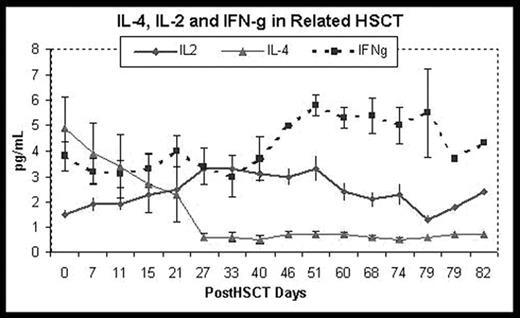Abstract
Conditioning regimen in HSCT induces production of inflammatory, regulatory and growth-promoting cytokines. Cytokines are known to mediate alloresponses and heighten GVHD. We prospectively studied sequential cytokine levels in 38 recipients of HSCT (autologous 10, allogeneic related 10 and unrelated 18). Serum TNFα, IL-1α, IL-1β, IL-2, IL-4, IL-5, IL-6, IL-10, IFNγ, G-CSF, GM-CSF, MIP1α, MIP1β levels were measured. Also, Th1 and Th2 cytokines were evaluated as a ratio: Th1/Th2 = IL-2 + IFNγ /IL-4 + IL-10 and Type 1/Type 2 = IL-2 + IFNγ / IL-4 + IL-5 + IL-10. Samples were collected at baseline prior to conditioning regimen and at 4–6 day intervals up to day 95 postHSCT. We report only the significant findings here. In autologous HSCT, IL-5 peaked 192-fold (288.5pg/mL, p=0.0005) at 7d postHSCT over preHSCT levels (1.5pg/mL). At day 15d postHSCT, IL-1α levels decreased 1.9-fold to 0.2 pg/mL under preHSCT levels of 2.3pg/mL and increased 1.9-fold at 40d postHSCT (p=0.0301). In related alloHSCT, the levels of IL-1β increased 3.1-fold to a peak of 16.2 pg/ml at 51d postHSCT (p=0.001) compared to preHSCT level of 5.2pg/mL. IL-2 levels increased 2.2-fold (p=0.001) during the 2nd month postHSCT compared to preHSCT (1.5pg/mL) levels. IL-4 decreased 8.1-fold (p=0.001) at 27d postHSCT compared to preHSCT levels (4.9 pg/mL). IFNγ levels increased 1.5-fold to a plateau after 51d postHSCT compared to preHSCT levels (5.8pg/mL, p=0.017). In unrelated alloHSCT, the levels of TNFα increased 1.7-fold at 60d and 68d postHSCT compared to preHSCT levels of (8.94 pg/mL). IL-10 levels increased 5-fold (p=0.028) to peak at 27d postHSCT compared to preHSCT levels of 2.5pg/mL and to levels after the 1st month postHSCT. The Type1/Type2 ratio decreased 2.5-fold (p=0.023) to a nadir at 27d postHSCT from baseline and returned to preHSCT values by approximately 3 months postHSCT. In unrelated HSCT, Th2 polarization increased in the first month postHSCT due to higher levels of IL-5 and IL-10. After the first month, Th2 dominance subsided, probably due to T-cell recovery and its response to histoincompatibility. The related HSCT showed marked Th1 polarization after the first month of HSCT during which high levels of IL-4 declined and levels of IL-2 and IFNγ increased (Figure 1). Increased IL-5 levels in autologous HSCT is consistent with reconstitution of humoral response in the absence of allostimulation. In summary, we demonstrate some of the dynamic cytokine interactions occurring in the clinical course of recipients undergoing autologous, allogeneic related or unrelated HSCT. The kinetics of Th1 and Th2 levels may reflect the cellular immune reconstitution that could help us design immunotherapeutic interventions.
Author notes
Disclosure:Ownership Interests: Lawrence Lum is founder of Transtarget. Research Funding: Michigan Life Science Grant. Membership Information: Lawrence Lum is on Berlex speaker’s Bureau.


This feature is available to Subscribers Only
Sign In or Create an Account Close Modal